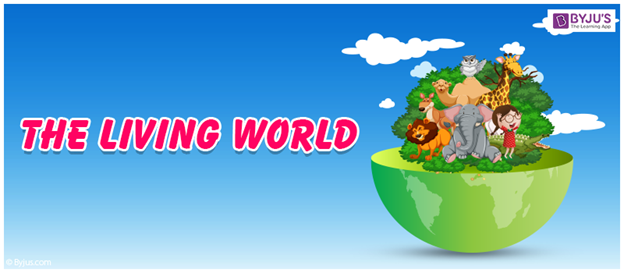Overview
The living world comprises different kinds of plants and animals. Cells are the building blocks of the living world and are the structural and functional unit of life. They have the capacity to alter their appearance and structure with the assistance of carbon-based and similar compounds (during metabolism) to carry out growth and reproductive activities.

The present-day life forms have evolved from the primitive ones through natural selection and hereditary validation over the generations. With certain fossils dated around 3.5 to 3.7 billion years ago, it could be stated that the studies stating that life began on this planet as early as 4.1 billion years ago could not be true entirely.
Also Read: Five Kingdom Classification
Composition of the Living World
The living organisms are made up of several organic and inorganic biomolecules. The inorganic compounds comprise water and minerals, whereas, the organic compounds comprise sugars, amino acids, proteins, fats, etc. These biomolecules play an important role in metabolism.
Role of Water
The human body is made up of 70-90% water. It helps in sustaining different life processes and no life is possible without water.
Role of Oxygen
Oxygen is required during aerobic respiration to produce energy that is essential for different metabolic activities.
Role of Sodium Chloride
The ionic form of sodium chloride plays an important role in the metabolic functions of the body.
Role of Proteins
Proteins are long chains of amino acids connected by peptide bonds. It plays a significant role in forming the structure of the organism. It can be broken down with the release of energy.
Role of Lipids
These are polymers of alcohol and fatty acids and perform several functions.
Characteristics of Living Organisms
Below are certain characteristics of living organisms:
Reproduction
The organisms have natural tendencies to grow and reproduce to form new offsprings. This could happen through sexual reproduction involving two organisms and asexual reproduction where one organism produces the other one. The newly reproduced organism will contain the same DNA composition of the parent organism.
Growth and Adaptation
The living organisms are bound to grow and adapt to their surroundings. To survive in the new environment, the organisms would have to adapt to their surroundings. For instance, seeds would sprout to full stems as they grow into full-grown plants. The adaptation of these plants happen, when they adjust to the lack of water, soil nutrient availability and pH level of water thereby achieving their growth and adaptability ends.
Homeostasis
In the world of living organisms, living beings have to maintain and control their internal states by the way of homeostasis. This would involve adjusting the internal pH level, temperature and water level. For instance, the human body would adjust to the changes in the external weather by wearing a sweater or remove the clothing layers in the body so as to adjust their body temperature.
Respiration
All living organisms have certain ways of respiration. During this process, the energy is released from the organism once the nutrition and food are broken down so as to assist in the growth, adapt and reproduction processes. In short, this is one of the basic processes without which no living organism could survive.
Also Read: Diversity in Living Organisms
To know more about the living world, its composition, and characteristics, keep visiting BYJU’S website or download BYJU’S app for further reference.
Download The PDFs for Daily Practice Problems and Worksheet for The Living World
Daily Practice Problems:-Download PDF Here
Worksheet:-Download PDF Here

very useful